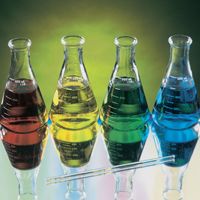My Cart
Your Shopping Cart is currently empty. Use Quick Order or Search to quickly add items to your order!
Jen Black
Product Manager, Chemistry and Inquiries in Science®

The College Board’s revision of the AP® Chemistry curriculum includes several structural changes. The major changes include the 6 Big Ideas of Chemistry—around which the course is built—a reduced breadth and increased depth of subject knowledge, an emphasis on inquiry and student-directed labs, and the expectation that students will apply the 7 Science Practices of AP Chemistry. These 7 Science Practices not only form a stand-alone requirement, but also are woven into the learning objectives along with the content.
The AP Chemistry science practices allow students to use the same tools real scientists employ to discover, test, and validate explanations of natural phenomena. In essence, the skills that scientists in all disciplines use in their work are the same skills AP Chemistry students will develop throughout the course.
The following are brief explanations of each science practice.
Science Practice 1: The student can use representations and models to communicate scientific phenomena and solve scientific problems.
This practice correlates with the College Board’s emphasis on students’ conceptual understanding of the particulate nature of matter. AP Chemistry students must demonstrate their understanding of various models of scientific phenomena by drawing, modeling, and describing what is happening on the particulate level to explain what is observed on the macroscopic level. Examples of this practice include drawing molecules using valence-shell electron-pair repulsion (VSEPR) theory and using the periodic table to predict an electron configuration.
Science Practice 2: The student can use mathematics appropriately.
Successful AP Chemistry students have always needed strong math skills. The revised curriculum requires that students not only use established formulas to solve problems, but also justify when to use those formulas and estimate quantities when appropriate. Use of the ideal gas law or approximating enthalpy changes are examples of this science practice.
Science Practice 3: The student can engage in scientific questioning to extend thinking or to guide investigations within the context of the AP course.
Students must become proficient at asking, honing, and assessing scientific questions. The revised laboratory component of the AP Chemistry curriculum will aid students in developing this science practice. The requirement for inquiry labs necessitates that students learn to formulate questions answerable with data.
Science Practice 4: The student can plan and implement data collection strategies in relation to a particular scientific question.
As with Science Practice 3, students will find many opportunities to apply Science Practice 4 in their inquiry-based labs. AP Chemistry students must know how to select, plan, collect, and evaluate sources of data to answer a question. Their experimental designs will require students to demonstrate mastery of this important scientific tool.
Science Practice 5: The student can perform data analysis and evaluation of evidence.
After selecting the best type of data to collect and subsequently collecting that data, students must effectively analyze the data, revisit their data collection plan in the face of results, and decide whether the data addresses the question at hand. Identifying patterns in chemical systems is 1 of the most useful applications of data analysis.
Science Practice 6: The student can work with scientific explanations and theories.
Students use their understanding of the previous 5 science practices to master Science Practice 6. They must first master basic scientific practices—from modeling to data analysis—in order to justify claims with evidence, explain scientific phenomena, explain the development of scientific theories, use theories and models to explain the scientific world, and assess alternative scientific explanations.
Science Practice 7: The student is able to connect and relate knowledge across various scales, concepts, and representations in and across domains.
No scientific discipline is an island, and this science practice requires students to realize and apply this concept. Students must both connect ideas across the field of chemistry and connect ideas between chemistry and other disciplines.
In the revised AP Chemistry curriculum, each essential knowledge point is paired with a scientific practice to form a learning objective. Each question on the exam will correspond to a learning objective. Therefore, making sure students can comfortably achieve each Learning Objective is imperative. Providing opportunities for your students to master the 7 Practices of AP Chemistry will help ensure their success in AP Chemistry.
To ease your transition into the AP Chemistry curriculum, Carolina developed a kit series—Carolina Investigations® for AP® Chemistry. The 16 kits in the series address the 6 Big Ideas of chemistry and meet the requirements of the course curriculum. Each kit focuses on a single Big Idea and offers the option to do either a guided activity or an inquiry activity with your students. And to help students prepare for the AP Chemistry Exam, all kits include Big Idea assessment questions that follow the AP Chemistry Exam’s free-response format.
AP® is a registered trademark of the College Board®, which was not involved in the production of, and does not endorse, these products.